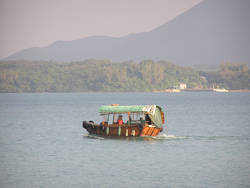Boat
2007 Schools Wikipedia Selection. Related subjects: Air & Sea transport
A boat is a craft or vessel designed to float on, and provide transport over, water.
A boat's propulsion will be achieved through any of the following means, individually or in combination: propellers, oars, paddles, setting poles, sails, paddlewheels, or water jets. Boats are generally smaller than ships, and although there is no hard rule between the two, the rule of thumb is that a boat can be mounted on a ship but not vice-versa.
Parts of a boat
The roughly horizontal, but cambered structures spanning the hull of the boat are referred to as the "deck". In a ship there are often several, but a boat is unlikely to have more than one. The similar but usually lighter structure which spans a raised cabin is a coach-roof. The "floor" of a cabin is properly known as the sole but is more likely to be called the floor. (A floor is properly, a structural member which ties a frame to the keelson and keel.) The underside of a deck is the deck head.
The vertical surfaces dividing the internal space are "bulkheads", they are important parts of the vessel's structure. The front of a boat is called the bow or prow. The rear of the boat is called the stern. The right side is starboard and the left side is port. Many boats have a section called the gralper. This section is designed to reduce water flow to the non-aerodynamic parts of the boat.
Types of boats


|
|
|
Unusual boats have been used for sports purposes - for example, in "bathtub races" which use boats made from bathtubs.
Boat building materials
Boats can be classified by the material used to build them. Until the mid 19th century all boats were wooden. As the forests of Britain and Europe continued to be over-harvested to supply the keels of larger wooden boats and the Industrial Revolution cheapened the cost of steel, the age of the steel ship began. In the mid 20th century aluminium gained popularity, being lighter and easier to work with than steel. Around the mid 1960s, boats made out of glass-reinforced plastic, more commonly known as fibreglass, became popular, especially for recreational boats. The coast guard refers to such boats as 'FRP' (for Fibreglass Reinforced Plastic) boats.
One of the advantages of fiberglass boats is that they are extremely strong, and do not rust, corrode, or rot. Fiberglass provides structural strength, especially when long woven strands are laid, sometimes from bow to stern, and then soaked in epoxy (i.e., plastic) to form the hull of the boat. One of the disadvantages of fiberglass is that it is heavy and to alleviate this, various lighter components can be incorporated into the design. One of the more common methods is to use cored fiberglass, with the core being balsa wood completely encased in fibreglass. While this works, the addition of wood makes the structure of the boat susceptible to rotting. Similarly, 'advanced composites' are simply other methods designed to introduce less expensive and, by some claims, less structurally sound materials.
Boat propulsion
The most common means are:
- Human power (rowing, paddling, setting pole etc.)
- Wind power (sailing)
- Motor powered screws
- Inboard
- Internal Combustion (gasoline, diesel)
- Steam (Coal, fuel oil)
- Nuclear (for LARGE boats)
- Inboard/Outboard
- Gasoline
- Diesel
- Outboard
- Gasoline
- Electric
- Paddle Wheel
- Water Jet ( Jet ski, Personal water craft, Jetboat)
- Air Fans (Hovercraft, Air boat)
- Inboard
Why boats float
A boat stays afloat because its weight is equal to that of the water it displaces. The material of the boat itself may be heavier than water (per volume!), but it forms only the outer layer. Inside it is air, which is negligible in weight. But it does add to the volume. The central term here is density, which is mass ('weight') per volume. One has to divide the mass of the boat (plus contents) as a whole by the volume below the waterline. If the boat floats than that is equal to the density of water (1 kg/l). One could say that to the water it is as if there is water there because the average density is the same. If one adds weight to the boat, the volume below the waterline will have to increase too, to keep the mass/weight balance equal, so the boat sinks a little to compensate.



